An Efficient and Straightforward Numerical Technique Coupled to Classical Newton’s Method for Enhancing the Accuracy of Approximate Solutions Associated with Scalar Nonlinear Equations
Abstract
This study concerns the development of a straightforward numerical technique associated with Classical Newton’s Method for providing a more accurate approximate solution of scalar nonlinear equations. The proposed procedure is based on some practical geometric rules and requires the knowledge of the local slope of the curve representing the considered nonlinear function. Therefore, this new technique uses, only as input data, the first-order derivative of the nonlinear equation in question. The relevance of this numerical procedure is tested, evaluated, and discussed through some examples.
1. Introduction
The resolution of nonlinear problems is an issue frequently encountered in several scientific fields such as mathematics, physics, or many engineering branches, for example, mechanics of solids [1–8]. In most cases, these problems are governed by nonlinear equations not having any analytical solution. In this regard, the introduction of iterative methods is therefore needed in order to provide a numerical approximate solution associated with any type of nonlinear equation [9–23]. Among these iterative algorithms, Classical Newton’s Method (CNM) [24, 25] is one of the most used mainly for the following reasons: (i) the simplicity for numerical implementation in any scientific computation software; (ii) the only knowledge of the first-order derivative of the considered function; (iii) the quadratic rate of convergence. In this paper, we propose a New Numerical Technique (NNT) based on geometric considerations which enable providing a more accurate approximate solution than that obtained by CNM. The present study is organized as follows: (i) in the first part, Section 2.1, we outline the scientific framework of this study, then, in second part, Section 2.2, we recall CNM including some convergence results, and, finally, in the third part, Section 2.3, we present NNT which uses only the first-order derivative of the considered nonlinear equation in order to enhance the predictive abilities of CNM; (ii) in Section 3, the numerical relevance of the proposed procedure is addressed, assessed, and discussed on some specific examples.
2. A New Numerical Technique (NNT) Combined with Classical Newton’s Method (CNM)
2.1. Problem Statement
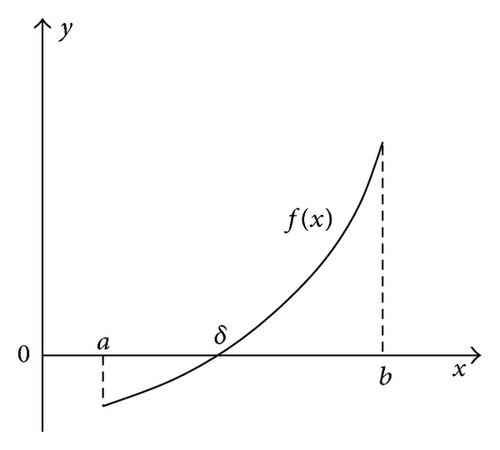
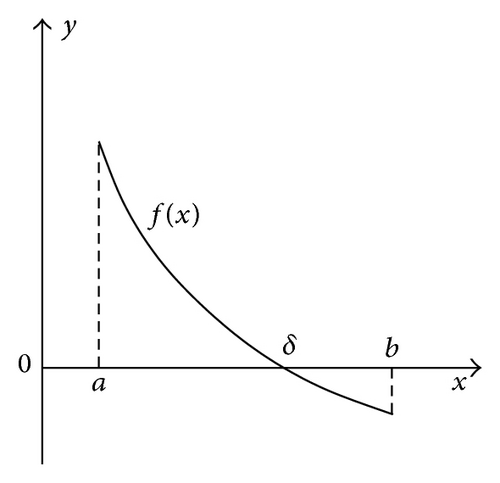
2.2. Classical Newton’s Method (CNM)
2.2.1. Iterative Algorithm
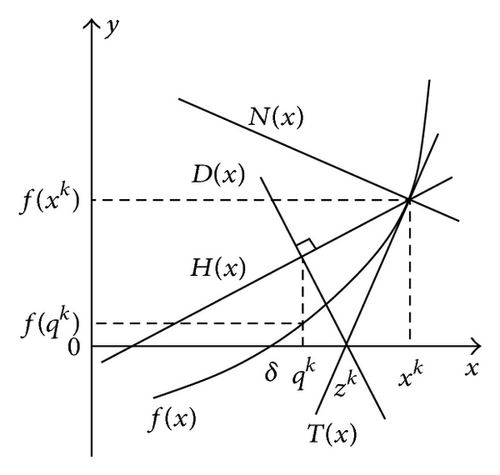
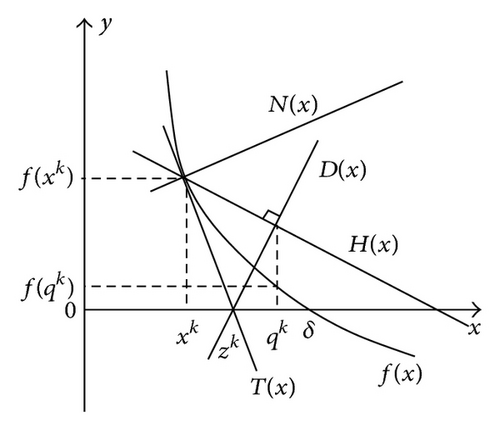
2.2.2. Convergence Results
2.3. New Numerical Technique (NNT)
2.3.1. Proposed Iterative Procedure
In this section, we propose a New Numerical Technique (NNT) for improving the accuracy associated with the approximate solution provided by CNM (see Section 2.2, which is used for finding the roots of scalar nonlinear equations. NNT is based on some practical geometric rules and requires only the determination of the local slope of the curve representing the considered nonlinear equation taking into account the first-order derivation (see [26–28]).
- (i)
We consider normal straight line N associated with the curve representing nonlinear equation f at point xk ∈ I (see [26, 27] and Figure 2):
() - (ii)
We introduce straight line H having direction vector which depends on the sum of direction vectors associated with normal and tangent straight lines passing by point (xk, f(xk)) (with ∀xk ∈ I; see Figure 2), that is:
() -
with
() -
where w1 = u1 + v1 and w2 = u2 + v2 are the components of direction vector associated with straight line H in any orthonormal basis .
- (iii)
Using CNM, we define kth iterative point zk ∈ I (with ∀x ∈ I; see (5) and also Figure 2):
() - (iv)
We introduce also straight line D in the following form (with ∀x ∈ I; see Figure 2):
() -
with
() - (v)
Combining (14)-(15) and (17)-(18), we adopt the solution x = qk ∈ I of the equation H(x) = D(x) (with ∀x ∈ I; see Figure 2), that is:
() -
According to (16) and (19), kth iterative point qk ∈ I associated with NNT (see Figure 2) can be rewritten (with ∀xk ∈ I):
()
- (i)
First condition [A1]: sgn (qk) = sgn (xk) and sgn (f(qk)) = sgn (f(xk)) and |f(qk)| < |f(zk)|.
- (ii)
Second condition [A2]: |f(qk)| < |f(zk)|.
2.3.2. Convergence Analysis
Similar to that in Section 2.2.2, we analyze the convergence associated with NNT which is presented in Section 2.2.
It is important to emphasize that the associated convergence order is linear-type (θ = 1) if 0 < τNNT ≤ 1 with condition [A] (i.e., [A1] or [A2]) and quadratic-type (θ = 2) if τNNT = 0 with condition [A] (i.e., [A1] or [A2]) and elsewhere with τCNM ≠ 0.
3. Numerical Examples
3.1. Some Preliminary Remarks
In this section, we propose to test, evaluate, and analyze the iterative numerical procedure presented in Section 2.3 on some particular examples. This New Numerical Technique (NNT) is coupled with Classical Newton’s Method (CNM) in order to provide a more accurate approximate solution associated with scalar nonlinear equations. The numerical predictions obtained by combining both NNT and CNM are compared with those provided by Third-order Modified Newton’s Method (TMNM) [22, 26]. All numerical results presented here have been made with Matlab software (see [25, 29–32]).
3.2. Examples
3.3. Results and Discussion
All the numerical results associated with scalar nonlinear functions f1 to f3 are presented in Tables 1–6 and also in Figures 3–20. For each scalar nonlinear function fj (with j = 1,2, 3), we test two guest points x0 for starting iterative procedure: (i) in the case of function f1, we adopt the first-guest point x0 = 3 (resp., second-guest point x0 = 10−3) and we show different approximate solutions xk (with k = 1, …, 10) and also the evolution of both residue error |f(xk+1)| and approximation error |xk+1 − xk| provided by Classical Newton’s Method (CNM; see Section 2.2), CNM coupled to the proposed New Numerical Technique (NNT) with both conditions [A1] and [A2] (CNM + NNT; see Section 2.3), and Third-order Modified Newton’s Method (TMNM; see Section 3.1) in Table 1 (resp., Table 2) and Figures 3–5 (resp., Figures 6–8); (ii) in the case of function f2, we adopt first-guest point x0 = 10 (resp., second-guest point x0 = −4) and we show different approximate solutions xk (with k = 1, …, 10) provided by CNM, CNM + NNT with both conditions [A1] and [A2], and TMNM in Table 3 (resp., Table 4) and Figures 9–11 (resp., Figures 12–14); (iii) in the case of function f3, we adopt first-guest point x0 = 10 (resp., second-guest point x0 = −1) and we show different approximate solutions xk (with k = 1, …, 10) provided by CNM, CNM + NNT with both conditions [A1] and [A2], and TMNM in Table 5 (resp., Table 6) and Figures 15–17 (resp., Figures 18–20). The obtained numerical results emphasize clearly that NNT combined with CNM is able to provide in the vast majority of cases a better approximate solution than that supplied only by CNM. In addition, on all results presented, condition [A2] seems to be more convenient than condition [A1]. For summary, NNT presents the main advantages of being a procedure: (i) “accurate” in terms of achieved approximate solution; (ii) “straightforward” to implement in computation software.
| Iteration (k) | CNM | CNM + NNT with condition [A1] | CNM + NNT with condition [A2] | TMNM |
|---|---|---|---|---|
| 0 | 3.0000000000 | 3.0000000000 | 3.0000000000 | 3.0000000000 |
| 1 | 2.2471426305 | 1.4942904056 (∗∗) | 1.4942904056 (∗∗) | 1.9644439737 |
| 2 | 1.6823826593 | 1.1286469200 (∗) | 0.7631581663 (∗∗) | 1.2884809024 |
| 3 | 1.2337388302 | 0.8906377962 (∗) | 0.7721173336 (∗) | 0.8906149334 |
| 4 | 0.9723200229 | 0.7878458749 (∗) | 0.7720250356 (∗) | 0.7746164630 |
| 5 | 0.8146707520 | 0.7723183427 (∗) | 0.7720250256 (∗) | 0.7720250503 |
| 6 | 0.7741430851 | 0.7720251266 (∗) | 0.7720250256 | |
| 7 | 0.7720302909 | 0.7720250256 (∗) | ||
| 8 | 0.7720250256 | |||
| 9 | 0.7720250256 | |||
| 10 |
| Iteration (k) | CNM | CNM + NNT with condition [A1] | CNM + NNT with condition [A2] | TMNM |
|---|---|---|---|---|
| 0 | 0.0010000000 | 0.0010000000 | 0.0010000000 | 0.0010000000 |
| 1 | 0.0082410886 | 0.0154821756 (∗∗) | 0.0154821756 (∗∗) | 0.0344577770 |
| 2 | 0.0505339927 | 0.1548613133 (∗∗) | 0.1548613133 (∗∗) | 0.3980194000 |
| 3 | 0.2182202963 | 0.4938846484 (∗) | 0.8311197179 (∗∗) | 0.9031891893 |
| 4 | 0.6163033790 | 0.8261543800 (∗) | 0.7760693275 (∗) | 0.7755098327 |
| 5 | 0.7975366151 | 0.7754244611 (∗) | 0.7720442199 (∗) | 0.7720250858 |
| 6 | 0.7727863680 | 0.7720385875 (∗) | 0.7720250260 (∗) | 0.7720250256 |
| 7 | 0.7720257060 | 0.7720250258 (∗) | 0.7720250256 (∗) | |
| 8 | 0.7720250256 | 0.7720250256 (∗) | ||
| 9 | ||||
| 10 |
| Iteration (k) | CNM | CNM + NNT with condition [A1] | CNM + NNT with condition [A2] | TMNM |
|---|---|---|---|---|
| 0 | 10.000000000 | 10.000000000 | 10.000000000 | 10.000000000 |
| 1 | 8.9811766535 | 7.9623533071 (∗∗) | 7.9623533071 (∗∗) | 8.4655416573 |
| 2 | 7.9456740785 | 5.8372149905 (∗∗) | 5.8372149905 (∗∗) | 6.8799380466 |
| 3 | 6.8825672128 | 3.5600762341 (∗∗) | 3.5600762341 (∗∗) | 5.2048513181 |
| 4 | 5.7803883041 | 1.4821734803 (∗∗) | 1.4821734803 (∗∗) | 3.4865001565 |
| 5 | 4.6404493806 | 0.9609028311 (∗) | 0.4402289741 (∗∗) | 2.0197617679 |
| 6 | 3.5056070182 | 0.6928062817 (∗) | 0.6483081663 (∗) | 1.0685736902 |
| 7 | 2.4744259573 | 0.6233620739 (∗) | 0.6199084714 (∗) | 0.6632122684 |
| 8 | 1.6461067325 | 0.6192585092 (∗) | 0.6192453069 (∗) | 0.6193191836 |
| 9 | 1.0635449602 | 0.6192449541 (∗) | 0.6192449540 (∗) | 0.6192449540 |
| 10 | 0.7354406002 | 0.6192449510 (∗) | 0.6192449540 |
| Iteration (k) | CNM | CNM + NNT with condition [A1] | CNM + NNT with condition [A2] | TMNM |
|---|---|---|---|---|
| 0 | −4.0000000000 | −4.0000000000 | −4.0000000000 | −4.0000000000 |
| 1 | −2.5987493208 | −1.1976336149 (∗∗) | −1.1976336149 (∗∗) | −2.1088093909 |
| 2 | −1.5803235380 | −0.2513579056 (∗) | 0.6858578709 (∗∗) | −0.7930763263 |
| 3 | −0.6950023819 | 1.1303884977 (∗) | 0.6226379112 (∗) | 1.4022343921 |
| 4 | 0.5489290102 | 0.7665675348 (∗) | 0.6192541648 (∗) | 0.7698587570 |
| 5 | 0.6234126286 | 0.6349082108 (∗) | 0.6192449540 (∗) | 0.6217981372 |
| 6 | 0.6192588436 | 0.6194395336 (∗) | 0.6192449540 (∗) | 0.6192449694 |
| 7 | 0.6192449541 | 0.6192449843 (∗) | 0.6192449540 | |
| 8 | 0.6192449540 | 0.6192449540 (∗) | 0.6192449540 | |
| 9 | ||||
| 10 |
| Iteration (k) | CNM | CNM + NNT with condition [A1] | CNM + NNT with condition [A2] | TMNM |
|---|---|---|---|---|
| 0 | 10.000000000 | 10.000000000 | 10.000000000 | 10.000000000 |
| 1 | 9.0104267607 | 8.0208535216 (∗∗) | 8.0208535216 (∗∗) | 8.5171506533 |
| 2 | 8.0146859130 | 5.9615544966 (∗∗) | 5.9615544966 (∗∗) | 6.9859301990 |
| 3 | 6.9847503720 | 3.9493415483 (∗∗) | 3.9493415483 (∗∗) | 5.3851997390 |
| 4 | 5.9189110435 | 2.4996523082 (∗∗) | 2.4996523082 (∗∗) | 4.0778432768 |
| 5 | 4.9180876708 | 1.7226271036 (∗) | 0.9467658294 (∗∗) | 3.0067861343 |
| 6 | 4.0738875311 | 1.3881795157 (∗) | 1.4273487664 (∗) | 1.8098899052 |
| 7 | 3.3404588095 | 1.3598140013 (∗) | 1.3607723321 (∗) | 1.3648044141 |
| 8 | 2.6091363141 | 1.3595986336 (∗) | 1.3595989925 (∗) | 1.3595986468 |
| 9 | 1.8194405679 | 1.3595986211 (∗) | 1.3595986211 (∗) | 1.3595986211 |
| 10 | 1.4045600984 |
| Iteration (k) | CNM | CNM + NNT with condition [A1] | CNM + NNT with condition [A2] | TMNM |
|---|---|---|---|---|
| 0 | −1.0000000000 | −1.0000000000 | −1.0000000000 | −1.0000000000 |
| 1 | 6.1409303723 | 6.1409303723 (∗) | 6.1409303723 (∗) | 14.5343055115 |
| 2 | 5.1148208484 | 4.0887116616 (∗∗) | 4.0887116616 (∗∗) | 13.0337347682 |
| 3 | 4.2379703013 | 2.6194618995 (∗∗) | 2.6194618995 (∗∗) | 11.5318478151 |
| 4 | 3.4892766889 | 1.8291595323 (∗) | 1.0397597354 (∗∗) | 10.0370297219 |
| 5 | 2.7676801225 | 1.4064394475 (∗) | 1.3966765848 (∗) | 8.5556896133 |
| 6 | 1.9776897481 | 1.3601688047 (∗) | 1.3599586541 (∗) | 7.0203746257 |
| 7 | 1.4417009128 | 1.3595987088 (∗) | 1.3595986561 (∗) | 5.3974911835 |
| 8 | 1.3613036994 | 1.3595986211 (∗) | 1.3595986211 (∗) | 4.1321703085 |
| 9 | 1.3595994046 | 3.1258556869 | ||
| 10 | 1.3595986211 | 1.9485648236 |
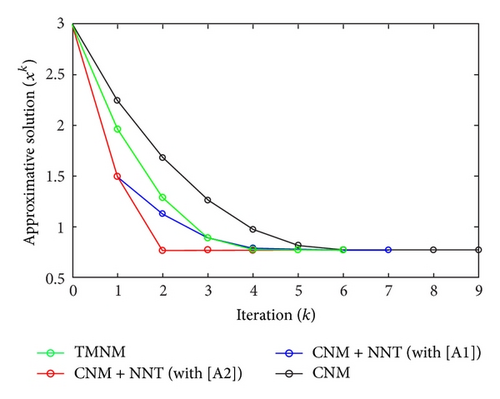
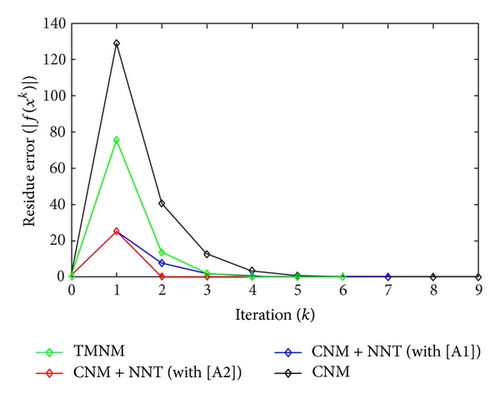
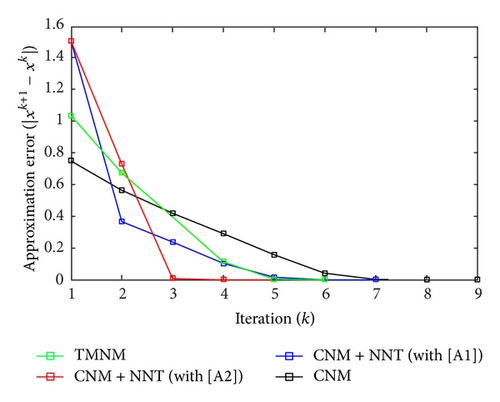
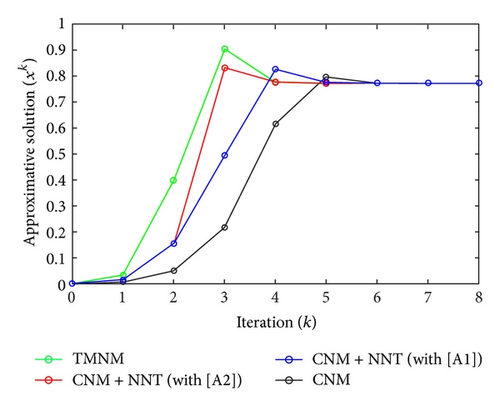
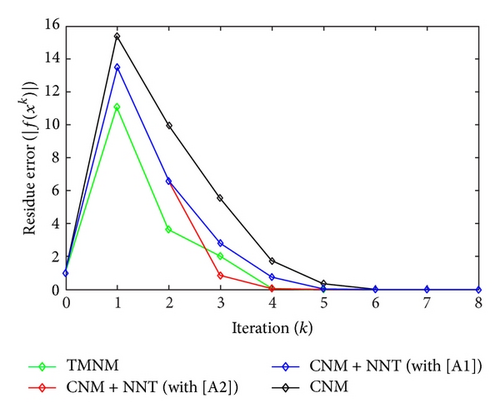
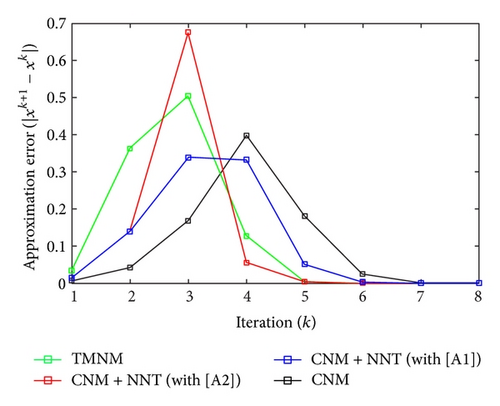
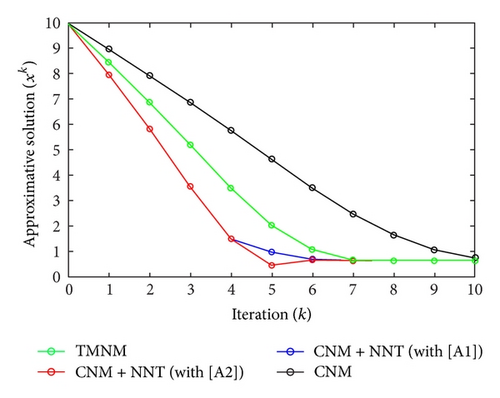
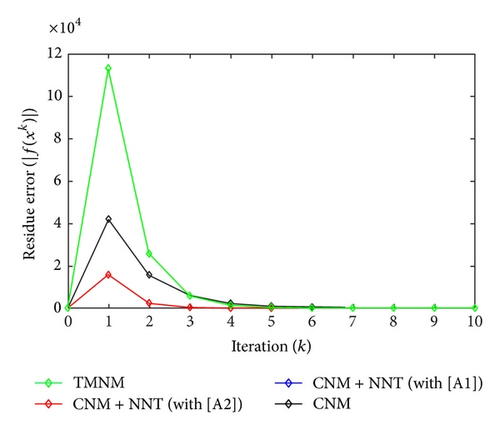
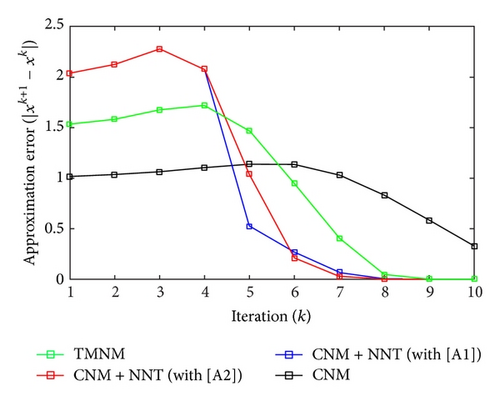
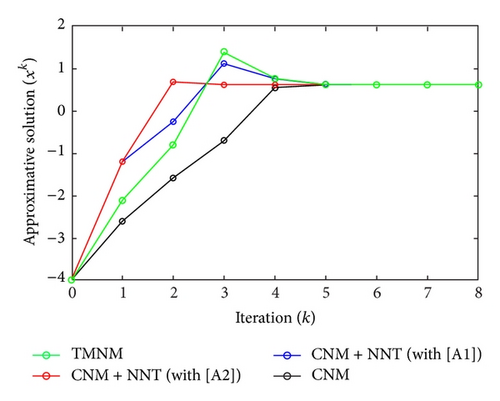
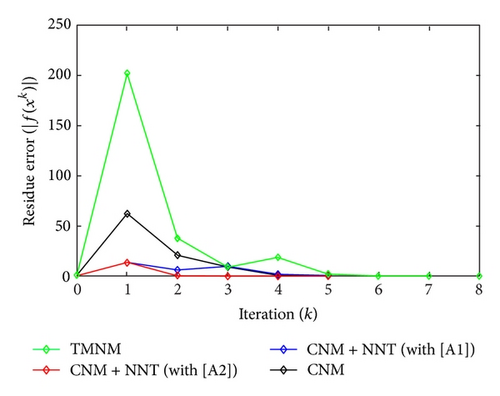
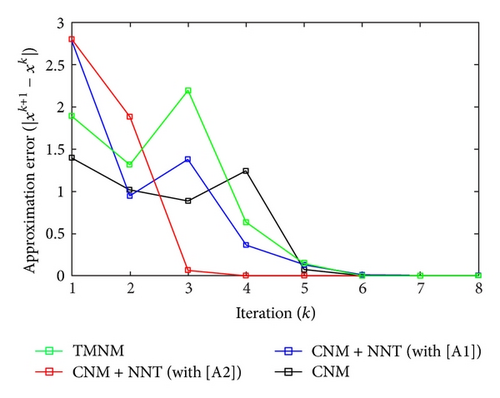
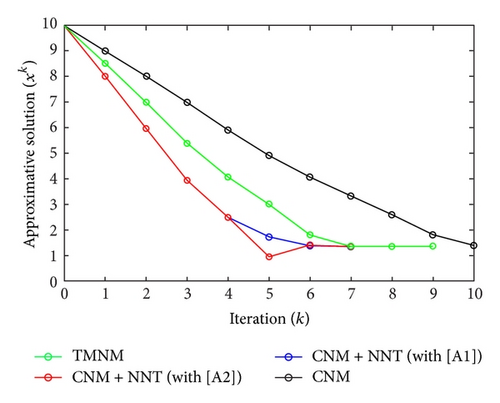
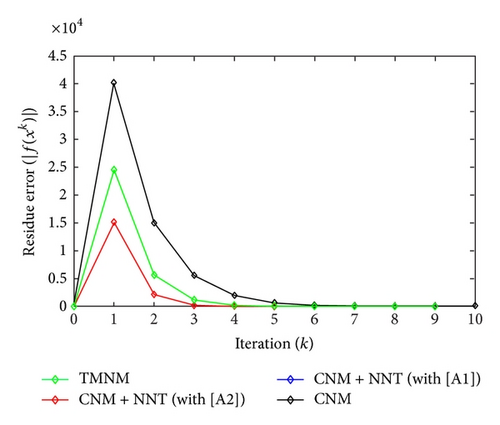
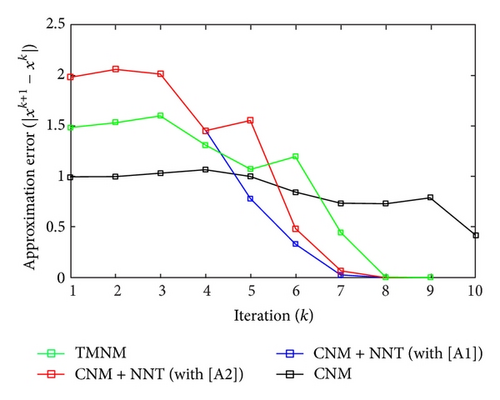
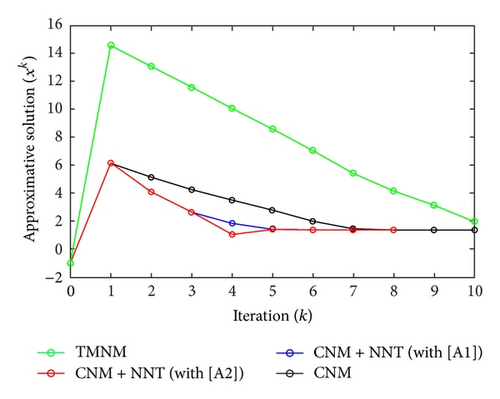
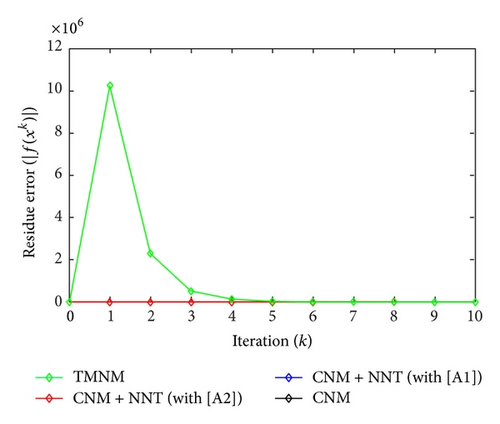
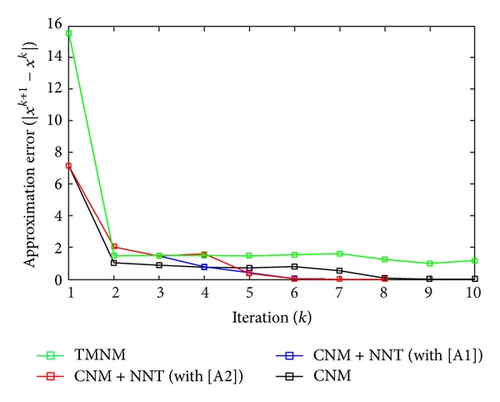
4. Concluding Comments
This study is devoted to a New Numerical Technique (NNT) to improve the accuracy of approximate solution provided by Classical Newton’s Method (CNM) and afford to have better numerical evaluation of the roots associated with the scalar nonlinear equations. As in CNM, this NNT requires only the determination of the first-order derivative of the nonlinear function under consideration. The predictive capabilities associated with NNT are shown on some examples.
Competing Interests
The author declares that they have no competing interests.




